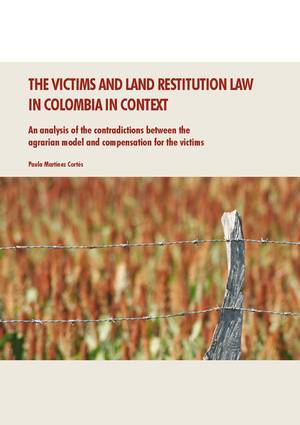Law 1448 passed in 2011, better known as the Victims and Land Restitution Law, has been promoted officially as a demonstration of ‘good will’ by the Juan Manuel Santos government in Colombia. The law represents a cog in the transitional policy aimed at facilitating steps towards a post-conflict scenario. However, the law’s main objective is to provide recognition to the victims of the Colombian armed conflict. This stands in contrast to the policy of denial enacted by the previous government. In order to provide recognition to the victims, the law aims to secure victims’ rights to access truth, justice and appropriate compensation while guaranteeing these people will never be victimized again. As such, this law is not merely about officially recognizing the conflict and its victims, it also aims to provide victims of the conflict with compensation.
These demonstrations of political will are representative of the unusual debate surrounding the conflict; a debate that has been confounded by a number of factors that make implementing the law particularly difficult. Furthermore, the law is formulated in a manner that reflects the diversity of the field it seeks to regulate, and this is clear throughout its 80 pages.1 However, this should not imply that the law is being successfully implemented on the ground. This is a particularly important factor, as the law was only designed to regulate the current transitional period. Moreover, the armed conflict in Colombia continues, and is fundamentally linked to conflict in the political and socioeconomic spheres.
Since Law 1448 was enacted in 2011, various reports have been published that evaluate the law’s potential and the challenges faced by its implementation. These reports range from an official analysis that presents data without providing significant references to their context;2 to publications in national media such as the Victims Report in the magazine Semana that illustrate the data by focusing on “victimizing events but not the background or meaning behind victimization”.3 Reports have also been published by NGOs and organizations in an attempt to defend human rights by pressing the Colombian state to fulfill its obligations. At the same time, the Victims and Land Restitution Law has been the object of intense debate among different national and international sectors.
This study seeks to contextualize Law 1448 and frame the discussion in relation to the spatial scenario in which the law is being applied: Colombian rural areas. The aim is then to highlight urgent issues that could act as indicators of rhetorical intention in favor of the (mainly rural) victims. These intentions are not consistent with the development policies imposed by the national government and actually hinder the provision of comprehensive reparations to the very people the law is supposed to defend.
Furthermore, this study aims to relate the land restitution process, and the possibilities of achieving its goals, to the recent national scandals associated with the extractivist, exclusionary and developmentalist model implemented by Juan Manuel Santos’ government. These policies include: i) land grabbing in the Colombian Altillanura, and other regions such as the Montes de María mountain range; ii) efforts by the government to dismantle the few legal instruments that defend indigenous, Afro-Colombian and peasant farmers’ territories; iii) and the repressive treatment of dissent and protests against the imposition of the government’s model. One example is the recent national agrarian strike. The government’s reaction to the strike was characterized by a lack of understanding of the conflict’s complexity: the conflict is more than just an armed conflict; it is also aggravated by diverse policy measures and official decisions.
Finally, this study highlights the role of the international community. Although many of the international community’s diverse actions have furthered the defense of human rights, at other times they have sharpened the conflict in Colombia.
Paula Martínez Cortés
Paula Martínez Cortés studies political science at the National University of Colombia. She is a master’s student in local rural development, and participates in the European Union Agris Mundus program.
Inhalt
Introduction
1. The context of the socioeconomic, political and internal armed conflict in Colombia
2. Serious human rights violations and denial of the conflict by the previous government (2002—2010)
3. Juan Manuel Santos’ government: ‘cleansing’ Colombia’s image in order to continue the extractivist, neoliberal model of development
4. Demonstrations of ‘good will’: the Victims Law and peace negotiations as inconsistent rhetoric
5. The debates about Law 1448 (2011), better known as the Victims and Land Restitution Law
5.1 A post-conflict law in the midst of an unfinished conflict
5.2 A transitional law that oscillates between the longing for peace and the persistence of war and impunity
5.3 Discriminatory treatment of victims by a law that is supposed to recognize them
5.4 ‘Fiscal sustainability’ is prioritized over compensation for the victims
5.5 Land restitution: consensus between supporters of opposing models of development
5.6 Recovering the land just to die for it
6. Favoring the land grabbers: two representative cases
6.1 Land grabbing in the Colombian Altillanura: the Orinoquia region
6.2 Land grabbing in the Montes de María mountain range in Bolívar and Sucre
7. Conclusion
8. Bibliography
Endnotes
Impressum
Forschungs- und Dokumentationszentrum
Chile-Lateinamerika – FDCL e.V.
Gneisenaustraße 2a, D-10961 Berlin
Fon: +49 30 693 40 29
Fax: +49 30 692 65 90
eMail: info@fdcl.org
Internet:
www.fdcl.org
Transnational Institute (TNI)
PO Box 14656, 1001 LD Amsterdam,
Niederlande
Fon: + 31 20 662 66 08
Fax: + 31 20 675 71 76
eMail: tni@tni.org
Internet:
www.tni.org
Author: Paula Martínez Cortés
Layout: Monika Brinkmöller
Print: Copy House
Cover photo: svenwerk / flickr.com
Translation: Simon Phillips (Linguatransfair)
© FDCL, Berlin, December 2013
The Victims and Land Restitution Law in Colombia in context
An analysis of the contradictions between the agrarian model and compensation for the victims
Paula Martínez Cortés| FDCL, TNI| December 2013
Produced with financial support from the European Commission.
The views expressed herein are those of the author and not of the EC.
Published by FDCL and TNI for the Hands off the Land Alliance

